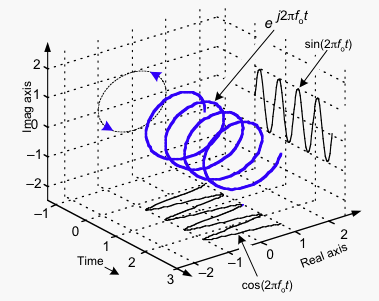There are some important signal processing points I keep having to re-derive, is rarely mentioned in the textbooks, and buried deep in the math.
What is the physical significance of negative frequencies?
FFT of real signals usually have both positive and negative frequencies in their spectrum. In feedback analysis, we simply ignore the negative frequencies and look at the positive part.
A good illustration of what is actually happening is below:

See also this stackexchange
The spiral can spin counter-clockwise or clock-wise, corresponding to positive or negative frequency. From the formula of Fourier Transform \(F(\omega)=\int_{-\infty}^{\infty} f(t)\exp{-j\omega t}dt\), we can see the frequency spectrum of a signal actually correspond to that of the spiral. Therefore both \(cos(\omega t)\) and \(sin(\omega t)\) are the sum of two complex exponentials. This is in fact true for all real, measurable signals.
In contrast, in Hilbert transform, the analytic signal \(x_c(t)=x_r(t)+jHT\{x_r(t)\}\) has single-sided spectrum, which is not physically realizable. However, it allows us to derive the instantaneous amplitude and frequency of the actual time-domain signal \(x_r(t)\).
Why is a linear phase response desirable for a system?
I always get tripped up by the language. I used to see a phase-response that is not flat and think the different frequencies have different phase lag, therefore they are going to combine at the output and the signal is going to be distorted.
The first part of that thought is correct, but the implication is different. 90-degrees phase-lag for a low-frequency signal is much longer in the time-domain as 90-degrees phase-lag for a high-frequency signal. Therefore, if all frequencies need to be delayed the same amount of time, the phase-lag need to be different.
In math, suppose an input signal \(x(t)=sin(\omega t)\) is filtered to output given by \(y(t)=sin(\omega(t-\tau))\), which is a pure delay by \(\tau\). This can then be written as \(y(t)=sin(\omega t-\omega\tau)=sin(\omega t+\phi(\omega))\), where \(\phi(\omega)=-\omega\tau\) is the phase response of the system, and the phase becomes more negative for larger frequencies.
And this is why linear phase response is desirable for a system.
